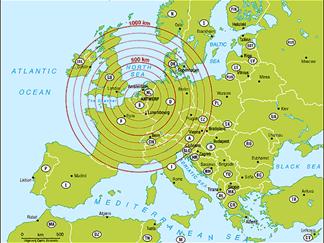|
The Antwerp
Intermodal Network
-Written by Frederic Krehl
The Antwerp Intermodal Network (AIN) is a project under initiative from the port of Antwerp, joined
by eighteen barge and rail operators from Belgium, the Netherlands, France and Germany. The goal of the conglomerate is to
promote the connection between the harbour and the hinterland by developing and improving a transportation network based on
multimodal modes of transport. The AIN project applied successfully for the Marco Polo program and was in course of that financially
supported by the European Union with 1.73 million Euros (European Commission, 2003).
|
Belgium |
|
|
Avelgem Container Terminal |
|
|
River Terminal Wielsbeke |
|
|
Intermodal Platform Ghent |
|
|
Port of Brussel |
|
|
Indipendent Barge Operators Grimbergen |
|
|
TCT Belgium Willebroek |
|
|
Transport Fluvial de Conteneurs Liège |
|
|
Port of Gent |
|
|
Watercontainertransport Meerhout |
|
|
Gosselin Container Terminal Deurne |
|
France |
|
|
Port of Lille |
|
|
Conteneurs Combinés Escaut / Terminal de Prouvy |
|
|
Conteneurs Combinés Escaut / Terminal de Béthune |
|
The Netherlands |
|
|
KTN Westerschelde |
|
|
Zeeland Container Terminal Terneuzen |
|
|
Barge Terminal Born |
|
|
Port of Moerdijk |
|
|
Oosterhout Container Terminal |
|
Germany |
|
|
CTS container terminal Cologne |
|
Figure 1: Members of the AIN |
The
Port of Antwerp
As
already mentioned is the port of Antwerp the initiator of the Antwerp Intermodal Network. The following information will give
a basic understanding of the harbour itself:
- The port of Antwerp is the largest harbour in Belgium and one of the 15 largest worldwide.
Measured by overall traffic it is the second largest in Europe, the third largest for liquid bulk and the fives largest for
dry bulk. In Europe only Hamburg and Rotterdam handling more containerized cargo and in non-containerized cargo the port of
Antwerp is even leading in Europe.
- In 2007 about 183 million tonnes of freight were handled at the port. During the
same period 16,689 seagoing ships called at Antwerp. Thereby the volume of incoming and outgoing goods is continuously growing
during the last years (Port of Antwerp, 2008).
- The port is located at the Estuary of the river Scheldt. Looking at the largest consumption
and production areas in Europe the port of Antwerp is the most central located Harbour.
- Especially its central location according to the largest consumption and production areas
in Europe is one of the strength of the port of Antwerp. The port is connected to the hinterland by ship, rail and road.

|
| Figure 2: Location of Antwerp in Europe |
References
Port of Antwerp (2005) Eighteen partners Join forces in Antwerp Intermodal
Network, Port of Antwerp – The Intermodal Companion, p.5
Port of Antwerp (2006) Geographical location, http://www.portofantwerp.com/html/02_PORTHANDBOOK/set_PH_02.html
[online]
European Commission (2003) Marco Polo – Call 2003 “Subset of 13 projects finally
contracted”
|

